In Reverb’s Show Us Your Space series, we’ve seen any number of impeccable home studios—like Stephen Lee Price’s Home Studio, Dragon Ship Studios, and more. While those high-ceilinged houses filled with top-level recording gear where players can record right where they live are a worthy goal for any musician, today, we’re looking at its polar opposite: a rehearsal space you make into a home.
A few years back, Eric Tessmer, an Austin-based blues-rock guitarist, songwriter, and singer, was facing rising rents in the ever-bustling Texas city. Instead of deciding to pay for both an apartment and a rehearsal space, he found a way to combine both.
Follow along below as Tessmer takes us through his room and gives tips for anyone out there hoping (or needing) to live where they play. To check out Eric Tessmer's music or catch him on the road as he tours this summer, check his website here.
Have you assembled a great practice space, project studio, or music workshop? Be sure to drop us a line at [email protected].

I’ll be perfectly blunt—the current state of my rehearsal room can be best described as "one person’s attempt at the age-old dilemma of how to neatly fit 10 pounds of shit into a five-pound sack." But it started out as my personal attempt to combine rehearsal and residence in the same space.
Several years back, when Austin was really starting to feel the major thrusts of its most recent growth cycle—or, more accurately, when the rising costs started to affect me personally—I decided that I was tired of paying for both a place to live and a place to practice.
My solution: Secure a lock-out rehearsal space with 24/7 access, loft a bunk, get a mini-fridge and microwave for food, join a gym for the shower, practice all the time, sleep and eat when needed. Basically: the ultimate artist pad.
So I did it—I figured out how to live and work in my rehearsal space—and I continued to do so for several years. However, it wasn’t remotely easy, and I’m not sure I’d recommend it to anyone. Having a tiny space that serves as your rehearsal space, your work shop, your storage space, and your home blurs more than a few lines that you may have never considered.
These days I no longer live in my rehearsal room, but that experience led me to have an extremely thought-out rehearsal/work space that maximizes every square inch.
The room I have now is actually across the hall from my original room where I began this whole experiment. The original room was maybe about 30-percent smaller and didn’t have its own bathroom—the closest bathroom available was a single toilet hallway bathroom down and across the hall. Flu season or food poisoning would take this arrangement’s particular compensations in the department of first-world comfort to a point well beyond inconvenient.
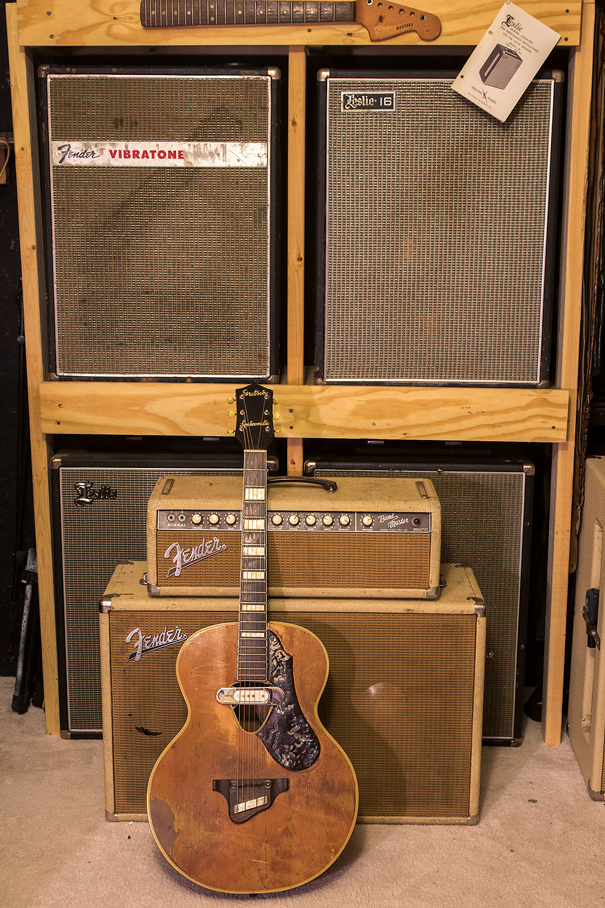
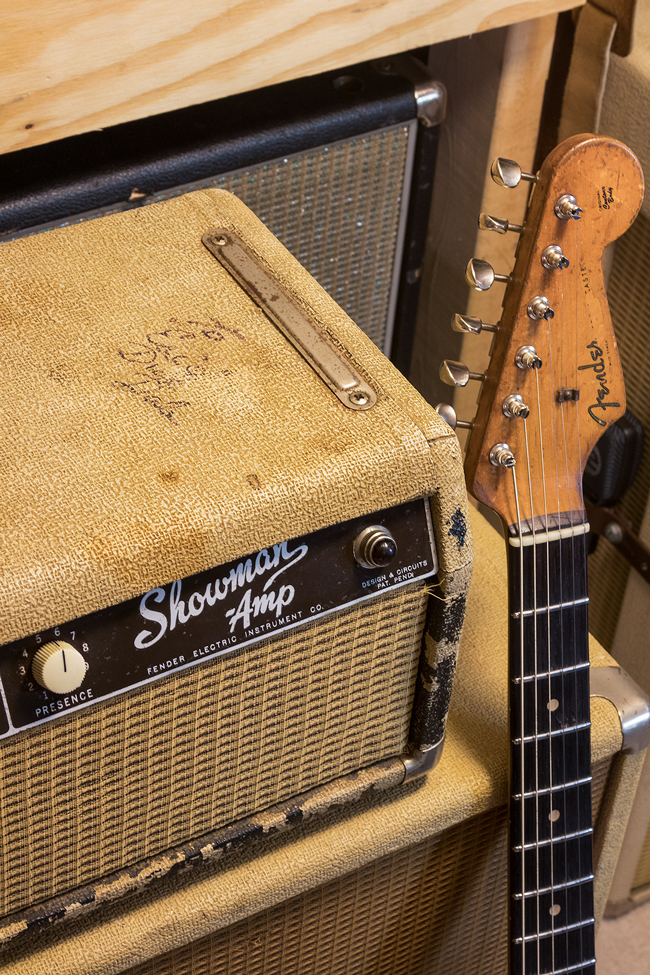
After about four years in the original room, a better room became available (larger, private bathroom) and I went for it. I took everything I learned from making a smaller space work for multiple purposes and did my best to optimize the larger space for any possible purpose. That’s the room you see now.
I started out the whole experiment with two simple ground rules for living in my rehearsal space: One, that the room’s function is first and foremost a practice space—live around that. And two, that I could never get any sort of attitude about anyone practicing in neighboring rooms while I was trying to sleep, ever. If anything, my living there was intruding on them.
I figured if I could discipline myself to maintain those two rules, everything else would just fall in place. Simple, right? Oh, hell no…
Here’s some crucial rules-of-thumb I learned the hard way and that are reflected in the pictures:
Keep everything you can off the floor. I mean everything you can. It’s the first step to keeping it clean, which in turn means your sanity. Hang the guitars from the walls or racks, build or find non-obtrusive shelves and take them to the ceiling. I built mine so that I could make the most of the space.
The amps and Leslies in my room are almost all on shelves, that serve three general purposes: easiest access, best use of vertical space to save floor space, and almost everything is off the ground in case of water pipes in the building backing up or breaking (it’s old, it happens). Plus, as a super cool side effect: It looks badass.

Get organized. Your life will be a giant shitshow if you don’t. Besides the amps being stored neatly on shelves, under the lofted bunk I built a wrap-around workbench where I change strings, build and repair pedals, do any computer work (where I’m writing this now), make PB&Js for my fat ass, etc.
There’s several parts bins meticulously labeled and bolted to the walls, pegboards holding tools, tape, wire and bulky components. You can see my two BMX bikes hanging off to the side, which brings up the most important part of being organized: everything needs a home (off the floor). You can also see the mini-fridge and microwave in this picture, all tucked away and whatnot (again, off the floor).

Have several lighting options. This is going to sound a little weird, maybe, but it’s actually made the space a lot more usable. If you plan to live in your rehearsal room, or just use your room for several different purposes, you’re about to spend a lot of time in that small space. Obviously in the workbench area I wanted surgery-grade lighting, but that doesn’t always lend itself to a chill practice session or a rehearsal.
I ran rope lights on the bottom side of all my shelves, lights under my workbenches and I have some smaller lamps scattered about the room. You can kill the fluorescent overhead lights and dial up countless options for low-key area lighting that won’t burn out your retinas.
Form follows function. It’s difficult to see in the photos, but on both sides of the main amp shelves, there’s a full PA, complete with subwoofer, lurking. (You can see the PA brain sitting on the sub to the left of the Leslies.)
It used to be the main PA that we used for the band and occasionally I still use it for random gigs, but storing it was a giant pain in the ass. So when I laid out the new room, I decided I’d "store" the PA setup in my room, but in a way that was tucked away and useful.
So now I have a badass rehearsal setup for vocals and through the magic of an aux cord with an XLR plug: my stereo system is capable of sterilizing any stray cats that wander within a half a mile radius.
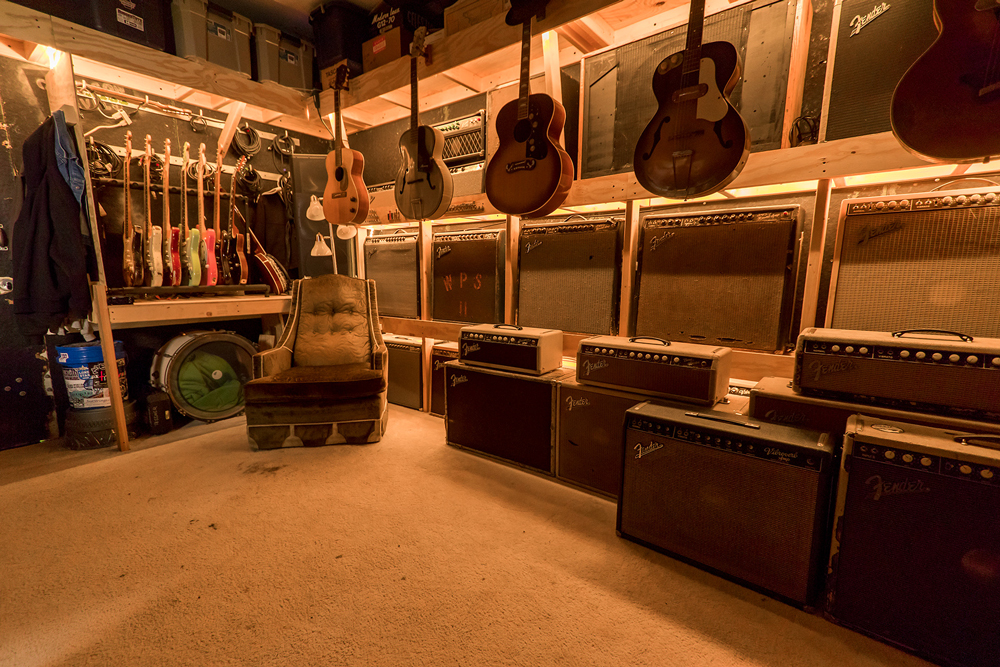
Kill the clutter. This goes hand-in-hand with the first two rules, but it stands by itself as well. There’s always gonna be random things you either can’t bring yourself to throw away and are notorious for "crapping up the place" by being out. I have one shelf 18 inches from the ceiling that runs the perimeter of the room (excepting the bunk) and it’s storage for things I don’t use everyday. Guitar cases, spare speakers, and "RS" (random shit).
The RS I put in plastic totes, speakers I keep in boxes if possible and guitar cases are stacked on top of each other. This way it minimizes the eyesore/distraction. FYI, speakers are safer in boxes anyway. There’s also a space above the Leslie shelves for speakers, transformers, some hifi stuff and Leslie parts. Below the guitar shelf there’s an extra bass cab, an old bass drum for rehearsal and demos and a stripped Marshall 4x12 project that I’ve done absolutely nothing about for five years, but someday…
Get connected. I got my rehearsal space wired up with Google Fiber, which has made the business side of my life so much easier and it’s saved me a lot time and money in fancy coffee shop visits merely to use their internet. My old percolator and fiber-based wifi keep me and my internet clipping right along at top speed. Which means more time for guitar.
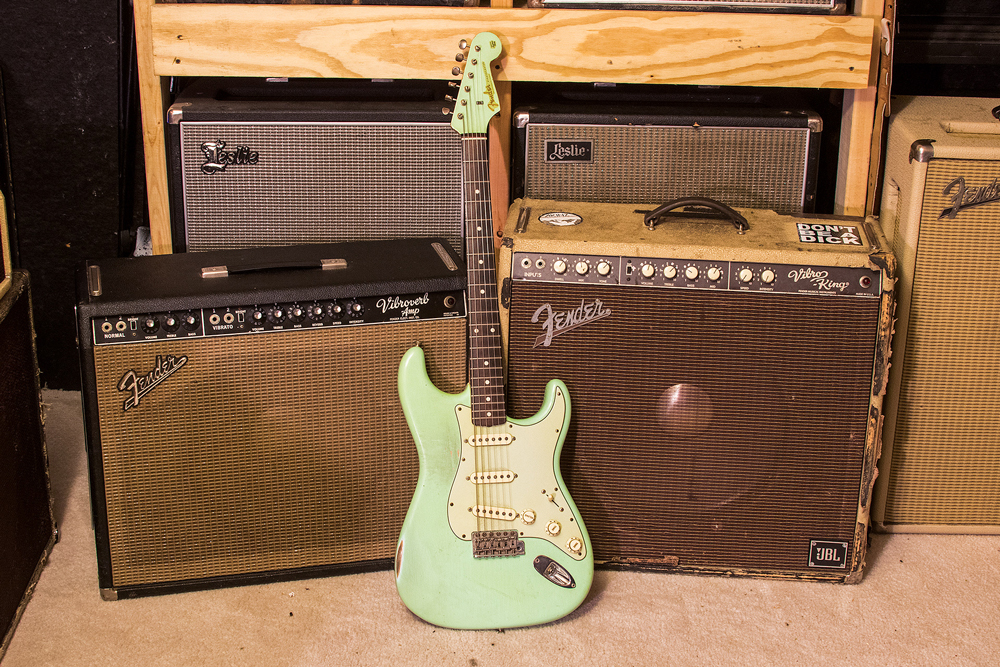
Get secure. Seriously, friend. Read this part several times. I have crazy amounts of locks and security measures protecting my room (which includes a camera and an alarm). I’ve found more people than I can count on all my fingers and toes, wandering the halls and testing random doors, or they’ll knock on my door and case out my room while trying to bullshit their way through a flimsy story, like how they want to start a rehearsal facility themselves and they "just wanted to see how the rooms are set up."
Almost every time this happens I’ve blatantly held my phone up to take a clear picture of their face. Then, if they were still around, I would walk them out to the parking lot and take pictures of their car and license plate. Several hid their face or were gone before I even took the first picture. Second, we’ve all worked too hard for some thief to come and attempt to steal away our gear. Thieves target musicians, especially since musicians are often careless. Don’t be careless about the thing you love the most—hold on, I’m gonna go write a song about that…
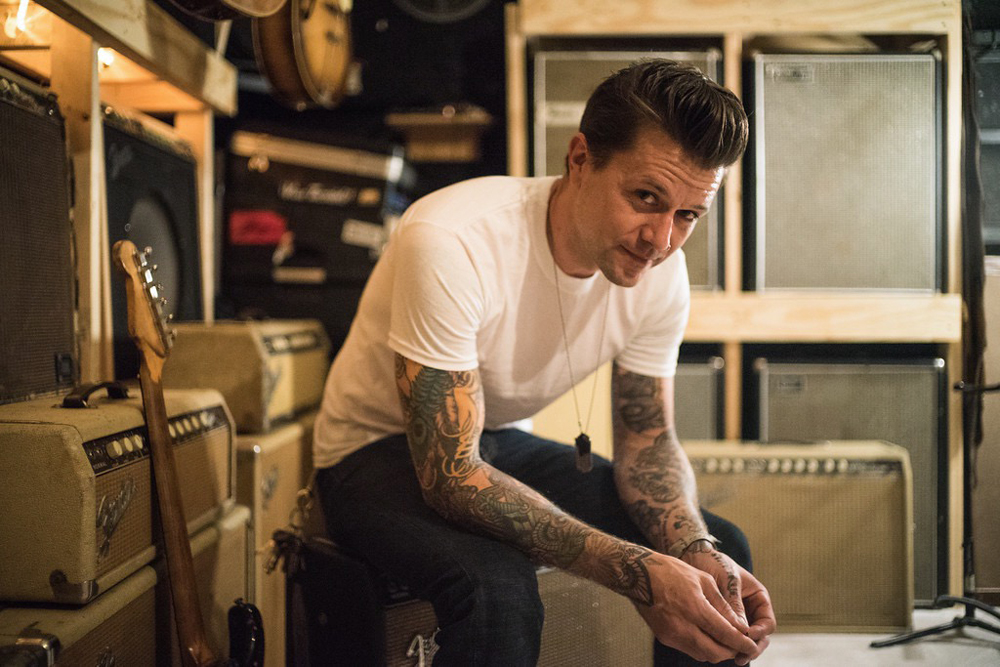
We'd love to see your studio, practice space, or gear lair too—whether it's a professional outfit or a weekend retreat. Contact us at [email protected].
